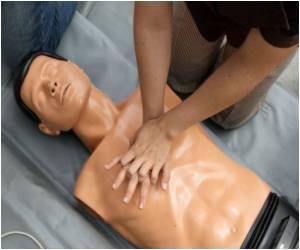An essential part of cardiopulmonary resuscitation after cardiac arrest is pushing on the chest to simulate the heart''s rhythmic pumping action.

However, the first systematic review of randomized clinical trials comparing mechanical to manual chest compressions has failed to demonstrate that one is superior to the other.
The only large recent study, in fact, found that patients treated with a mechanical device fared more poorly. Yet, problems in how the study took place might explain these unexpected results, the reviewers said.
"Based on the evidence as it currently stands, it''s difficult to say for sure whether these devices harm or benefit," said Steven C. Brooks, MD, assistant professor of medicine at University of Toronto and lead review author. "There is a need for more studies."
The reviewers analyzed data from four randomized controlled trials, involving a total 868 patients.
The review appears in the latest issue of The Cochrane Library, a publication of the Cochrane Collaboration, an international organization that evaluates medical research. Systematic reviews draw evidence-based conclusions about medical practice after considering both the content and quality of existing medical trials on a topic.
Advertisement
Several manufacturers have developed devices using bands or pistons to rhythmically compress the chest, in an attempt to overcome these problems.
Advertisement
The studies'' findings were inconsistent: three small studies suggested that mechanical devices were beneficial, and the one large study found harm. Taken together, they provided "insufficient evidence" to draw meaningful conclusions, the authors wrote.
The large study compared 767 patients who had cardiac arrest outside the hospital and underwent CPR with chest compressions either applied manually or delivered automatically by a device using a band around the chest.
In the study, 3.1 percent of the patients receiving mechanical chest compressions survived to hospital discharge with no or relatively mild signs of brain damage, compared with 7.5 percent of those who had manual compressions.
"There were major methodological issues that might explain why [this study] came out with such a different answer than what was expected from previous small studies and from physiological studies," Brooks said.
These included the fact that the finding of harm depended on results from a single study site, where the CPR procedure was changed midway through the study, and that significantly more patients in the mechanical group were thin or morbidly obese than in the manual group.
More important, patients receiving mechanical compression waited longer for defibrillation, an electrical shock delivered to restart the heart, compared to the manual group. It is likely that the use of a mechanical device delayed compressions, Brooks said.
"Resuscitation in the field is commonly done in tight spaces and needs to be like a well- choreographed ballet," he said. "One could hypothesize that the machine would work well when you get it on the chest properly, but the devil''s in the details, how fast you can deploy the device and incorporate it into the ballet of resuscitation."
Robert E. O''Connor, M.D., chair of emergency medicine at University of Virginia, called the review "extremely well done," and said that "even though it didn''t completely answer the question, it gives future investigators some direction for CPR studies in general."
He proposed that the question is not "whether the devices work - in the laboratory they do - but whether you can get them on quickly enough without interrupting chest compressions for any length of time. You pay a price for applying any device. The question is whether the price is worth it."
Chest compression devices are "very attractive to anyone who performs CPR," O''Connor said. "And there may be some use for them, particularly in EMS agencies with limited numbers of rescuers. But you really have to pay strict attention to timing."
Brooks said that to his thinking, his findings do not indicate that agencies should stop using chest compression devices, "but the evidence suggests the need for caution, and a focus on how the device is deployed - quickly, and with minimum interruption."
He said that a much larger international study comparing manual and mechanical chest compressions, scheduled for completion in 2012, should provide more definitive answers.
TERMS OF USE: This story is protected by copyright. When reproducing any material, including interview excerpts, attribution to the Health Behavior News Service, part of the Center for Advancing Health, is required.
The Cochrane Collaboration is an international nonprofit, independent organization that produces and disseminates systematic reviews of health care interventions and promotes the search for evidence in the form of clinical trials and other studies of interventions. Visit http://www.cochrane.org for more information.
Brooks SC, Bigham BL, Morrison LJ. Mechanical versus manual chest compressions for cardiac arrest (Review). Cochrane Database of Systematic Reviews 2011, Issue 1.
Source-Newswise








